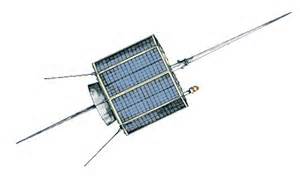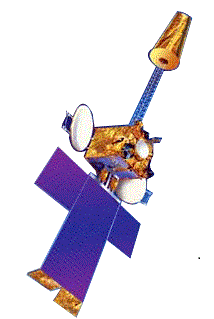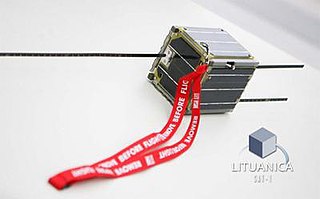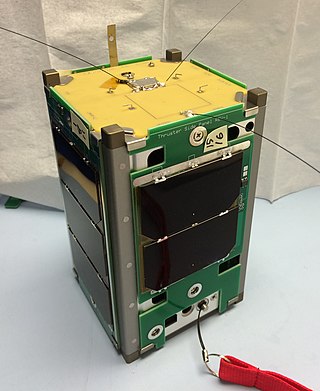| Mission type | Communications |
|---|---|
| Operator | U.S. Navy [1] |
| COSPAR ID | 2015-025E [1] |
| SATCAT no. | 40655 [1] |
| Spacecraft properties | |
| Bus | 1.5U Cubesat |
| Manufacturer | George Washington University |
| Launch mass | 1.9 kilograms (4.2 lb) |
| Dimensions | 10 by 10 by 15 centimetres (3.9 in × 3.9 in × 5.9 in) |
| Start of mission | |
| Launch date | 20 May 2015, 15:05 UTC |
| Rocket | Atlas V 501 AV-054 |
| Launch site | Cape Canaveral SLC-41 |
| End of mission | |
| Disposal | Decommissioned |
| Orbital parameters | |
| Reference system | Geocentric |
| Regime | Low Earth |
| Semi-major axis | 6,772 kilometres (4,208 mi) [2] |
| Eccentricity | 0.109060 [2] |
| Perigee altitude | 327.8 kilometres (203.7 mi) [2] |
| Apogee altitude | 475.5 kilometres (295.5 mi) [2] |
| Inclination | 54.9773° [2] |
| Period | 92.4 minutes [2] |
| RAAN | 320.0527° [2] |
| Argument of perigee | 152.7277° [2] |
| Mean motion | 15.5764196 [2] |
| Epoch | 26 June 2018 [2] |
| Transponders | |
| Band | FM |
BRICSat-P or OSCAR 83 (NO-83) previously known as PSat-B, is a U.S. technology demonstration satellite and an amateur radio satellite for Packet Radio. BRICSat-P (Ballistic Reinforced Communication Satellite) is a low cost 1.5U CubeSat built by the U.S. Naval Academy Satellite Lab in collaboration with George Washington University, that will demonstrate on-orbit operation of a Micro-Cathode Arc Thruster (μCAT) electric propulsion system and carries an amateur communication payload.
A four μCAT thruster head system was placed on one side of the spacecraft around the center of gravity and will de-tumble the satellite from its initial expulsion, demonstrate rotational control about 2 axes, and perform a delta-V end of life scenario. Orbital analyses performed indicate that the four thruster-head system is able to fit in a 1.5U Cubesat with low power consumption such that other subsystems such as communication systems can perform normally. Dynamics analysis has been performed in MATLAB Simulink and STK that shows the thrusters can successfully perform the attitude control maneuvers. The project is fully funded and launched on 20 May 2015. [1]
BRICSat-P suffered from power budget problems and has been unable to support all of its primary missions. [3]
BRICSat has 2 amateur communication payload on boards: APRS constellation transponder with downlink on 437.975 MHz and with uplink on 145.825 MHz 1k2 and 9k6 AX25 PSK31 transponder with a 28.120 MHz uplink (2.5 kHz bandwidth) and a UHF FM downlink. [4]
The Ku band is the portion of the electromagnetic spectrum in the microwave range of frequencies from 12 to 18 gigahertz (GHz). The symbol is short for "K-under", because it is the lower part of the original NATO K band, which was split into three bands because of the presence of the atmospheric water vapor resonance peak at 22.24 GHz, (1.35 cm) which made the center unusable for long range transmission. In radar applications, it ranges from 12 to 18 GHz according to the formal definition of radar frequency band nomenclature in IEEE Standard 521–2002.

The Indian National Satellite System or INSAT, is a series of multipurpose geostationary satellites launched by the Indian Space Research Organisation (ISRO) to satisfy telecommunications, broadcasting, meteorology, and search and rescue operations. Commissioned in 1983, INSAT is the largest domestic communication system in the Indo-Pacific Region. It is a joint venture of the Department of Space, Department of Telecommunications, India Meteorological Department, All India Radio and Doordarshan. The overall coordination and management of INSAT system rests with the Secretary-level INSAT Coordination Committee.

Milstar is a constellation of military communications satellites in geosynchronous orbit, which are operated by the United States Space Force, and provide secure and jam-resistant worldwide communications to meet the requirements of the Armed Forces of the United States. Six spacecraft were launched between 1994 and 2003, of which only five were operational after launch; the third launch failed, both damaging the satellite and leaving it in an unusable orbit.
HAMSAT also known as HAMSAT INDIA, VU2SAT and VO-52 is a microsatellite weighing 42.5 kilograms (93.7 lb), providing amateur radio satellite communications services for Indian and international amateur radio operators. This satellite carries the in-orbit designation of VO-52, and is an OSCAR series satellite.

The Lincoln Experimental Satellite series was designed and built by Lincoln Laboratory at Massachusetts Institute of Technology between 1965 and 1976, under USAF sponsorship, for testing devices and techniques for satellite communication.

AMSAT-OSCAR 7, or AO-7, is the second Phase 2 amateur radio satellite constructed by the Radio Amateur Satellite Corporation (AMSAT). It was launched into Low Earth Orbit on November 15, 1974 and remained operational until a battery failure in 1981. After 21 years of apparent silence, the satellite was heard again on June 21, 2002 – 27 years after launch. At that time the public learned that the satellite had remained intermittently functional and was used surreptitiously for communication by the anticommunist opposition Fighting Solidarity during martial law in Poland.
SSETI Express was the first spacecraft to be designed and built by European students and was launched by the European Space Agency. SSETI Express is a small spacecraft, similar in size and shape to a washing machine. On board the student-built spacecraft were three CubeSat picosatellites, extremely small satellites weighing around one kg each. These were deployed one hour and forty minutes after launch. Twenty-one university groups, working from locations spread across Europe and with very different cultural backgrounds, worked together via the internet to jointly create the satellite. The expected lifetime of the mission was planned to be 2 months. SSETI Express encountered an unusually fast mission development: less than 18 months from kick-off in January 2004 to flight-readiness.
AMSAT-OSCAR 16, also known as AO-16 and PACSAT, is the in-orbit name designation of an amateur radio satellite of the OSCAR series. It was built by AMSAT and was launched on 22 January 1990 from Kourou, French Guiana on an Ariane 4 launch vehicle. It is in Sun synchronous low Earth orbit.

INSAT-3A, a multipurpose satellite built by ISRO was launched by Ariane in April 2003. It is located at 93.5 degree East longitude. It is third satellite in INSAT-3 series after INSAT-3B & INSAT-3C. Built at a cost of $53 mn, it provides communication, weather, and search and rescue services.
An amateur radio satellite is an artificial satellite built and used by amateur radio operators. It forms part of the Amateur-satellite service. These satellites use amateur radio frequency allocations to facilitate communication between amateur radio stations.
Co-location is the placing of two or more geostationary communications satellites in orbit, in close proximity so that to reception equipment on the ground they 'appear' to occupy a single orbital position. The technique as applied to a group of TV satellites from a single operator was pioneered by SES with the Astra satellites at 19.2°E.

OSCAR IV was the fourth amateur radio satellite launched by Project OSCAR and the first targeted for Geostationary orbit on 12 December 1965. The satellite was launched piggyback with three United States Air Force satellites on a Titan IIIC launch vehicle. Due to a booster failure, OSCAR 4 was placed in an unplanned and largely unusable Geostationary transfer orbit.

LituanicaSAT-1 was one of the first two Lithuanian satellites. It was launched along with the second Cygnus spacecraft and 28 Flock-1 CubeSats aboard an Antares 120 carrier rocket flying from Pad 0B at the Mid-Atlantic Regional Spaceport on Wallops Island to the International Space Station. The launch was scheduled to occur in December 2013, but later was rescheduled to 9 January 2014 and occurred then. The satellite was broadcasting greetings of Lithuanian president, Mrs. Dalia Grybauskaitė. The satellite was deployed from the International Space Station via the NanoRacks CubeSat Deployer on February 28, 2014. All LituanicaSAT-1 subsystems have been turned on, tested and proved to be working properly. The mission is considered a complete success by its team of engineers. The mission ended upon the reentry and disintegration of the satellite on July 28, 2014.

Es'hail 2 is a Qatari satellite, launched aboard a SpaceX Falcon 9 rocket on November 15, 2018. Es'hail 2 was built by Japan's Mitsubishi Electric company, and operates at 26° East longitude along a geostationary orbit to provide direct-to-home television services in the Middle East and North Africa region. The satellite features 24 Ku-band and 11 Ka-band transponders to provide direct broadcasting services for television, government and commercial content distribution. In addition to commercial services, the payload of Es'hail 2 includes a linear transponder with a bandwidth of 500 kHz and 8 MHz for the amateur radio satellite service, with uplink on 2.4 GHz and downlink on 10.45 GHz.
Intelsat 706 is a geostationary communication satellite that was built by Space Systems/Loral (SSL). It is located in the orbital position of 157 degrees east longitude and it is currently in an inclined orbit. The same is owned by Intelsat. The satellite was based on the LS-1300 platform and its estimated useful life was 15 years.
ParkinsonSAT, PSat or Naval Academy OSCAR 84 is a U.S. technology demonstration satellite and an amateur radio satellite for Packet Radio. It was built at the U.S. Naval Academy and was planned as a double satellite. The name ParkinsonSAT was chosen in honor of Bradford Parkinson, the father of the GPS system. After successful launch, the satellite was assigned the OSCAR number 84.

BRICSat-2, or USNAP1, was an experimental amateur radio satellite from the United States Naval Academy that was developed in collaboration with George Washington University. BRICSat-2 was the successor to BRICSat-P. AMSAT North America's OSCAR number administrator assigned number 103 to this satellite; in the amateur radio community it was therefore called Navy-OSCAR 103, short NO-103.
PSAT-2 is an experimental amateur radio satellite from the U.S. Naval Academy, which was developed in collaboration with the Technical University of Brno in Brno, Czech Republic. AMSAT North America's OSCAR number administrator assigned number 104 to this satellite; in the amateur radio community it is therefore also called Navy-OSCAR 104, short NO-104.
OSCAR 8 is an American amateur radio satellite. It was developed and built by radio amateurs of the AMSAT and launched on March 5, 1978 as a secondary payload together with the Earth observation satellite Landsat 3 from Vandenberg Air Force Base, California, United States.
Weber-OSCAR 18 is an American amateur radio satellite.